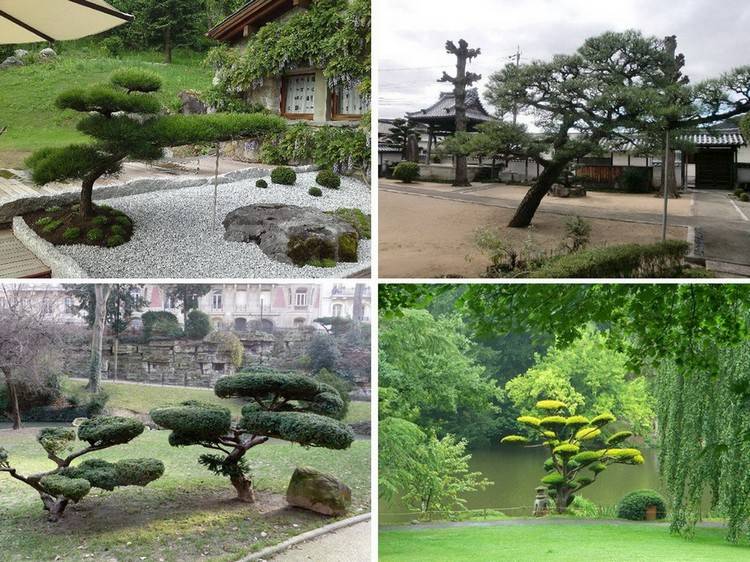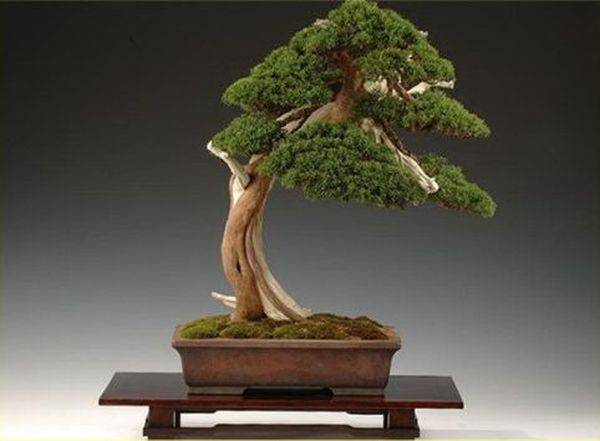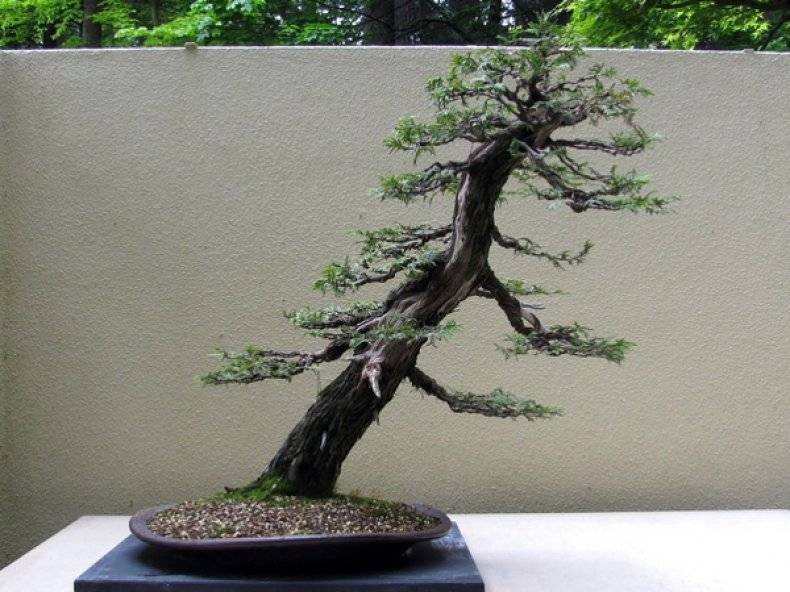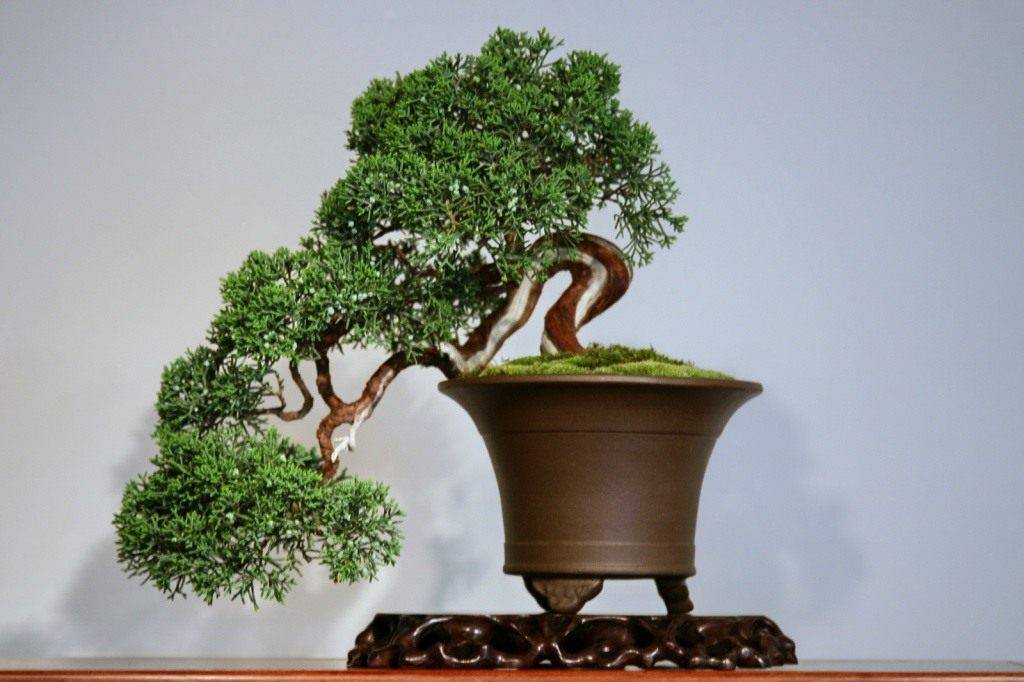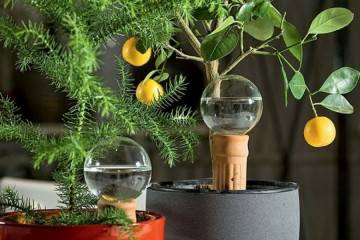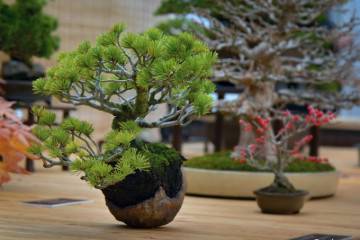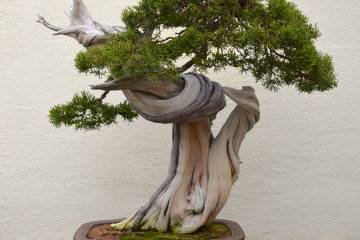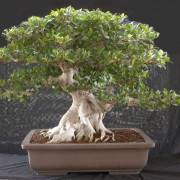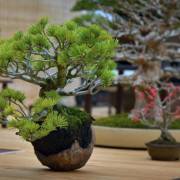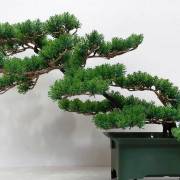DIY pine bonsai in the garden
Content:
A miniature living tree was first created about a thousand years ago by order of the Chinese emperor, who conceived the idea of decorating the palace with a tiny kingdom of plants. From there, the practice of cultivating bonsai came to Japan. The cultivation of graceful trees has become a classic in the Japanese gardening art and has spread throughout the world.
Description and main types
Bonsai miniature trees - a reproduction of naturally occurring plants. In Japan, bonsai cultivation is a holistic worldview that combines spirituality and physicality. In Russia, miniature trees have appeared quite recently. Undemanding pine is perfect for creating whimsical shapes.
An amateur to grow such a tree with his own hands just needs patience and knowledge of how to make bonsai from pine. The tree is formed artificially according to special rules:
- the trunk should be strong and impressive with a compacted support and a rhizome protruding from the soil;
- there are usually few branches so that they combine with each other, creating a tree its unique appearance;
- they try to shape the pine into one of 15 classic designs.
The shape of a pine bonsai should resemble a plant growing in nature. The most important task when growing a tree is to slow down its growth. For growing bonsai, 4 types of pine are usually used.
Japanese black
Pinus thunbergii is most often taken as a basis for the cultivation of a tiny plant due to the originality of its bark, crown density, slow growth, endurance and unpretentiousness. The tree easily withstands very harsh conditions, is able to survive even on rocky soil.
Japanese white
Pinus parviflora is single-barreled and multi-barreled. Over time, the branches acquire a grayish-blue hue, and the delicate thin needles with curved tips justify the specific name of the tree. This species is very popular in garden plots.
Mountain
Mountain bonsai pine (mugus), not too capricious in cultivation, with favorable care, has a dense crown, which allows it to be formed in a variety of styles. The bark of a young tree is purple in color, and the pine blooms with light purple inflorescences.
Ordinary
Parviflora is the easiest option for domestic amateurs. He does not require special conditions, he easily lends itself to the formation of the desired look. The common pine bonsai is distinguished by paired yellowish-green needles and scaly brown-reddish bark. It usually has low hanging branches giving it a graceful shape.
Bonsai pine styles
The images on the basis of which miniature trees are classified are similar to the species diversity of plants in nature. However, they can be changed during the cultivation process in accordance with the author's intention. Bonsai styles differ in the angle of inclination of the trunk, the placement of branches and their combination:
- the formal vertical style (tekkan) is distinguished by a flat trunk thickened downwards with regular placement of branches;
- the informal vertical style (moyogi) is characterized by a curved trunk with a decrease in bends towards the top;
- in the oblique style (shakkan), the trunk is inclined at an angle of 60-80 degrees, as if under the influence of a constant strong wind;
- The double-trunk style (shokan), which is often found in nature, is characterized by a single crown, a common root system and different trunk thicknesses. By tradition, it is given to couples in love;
- cascading bonsai (kengai) are usually grown in tall pots. It resembles a tree on the edge of a cliff, bent under the weight of a snowfall or a hail of stones. The branches are arranged horizontally to balance the composition;
- the semi-cascading style (khan-kengai) is found in natural conditions on the banks of reservoirs and in the mountains. The base of the trunk grows first upward, and then tilts to the side and downward. The top is located at the level of the edge of the pot;
- the literary (bohemian) style (bunzings) with a bare vertical trunk and a crown at the top symbolizes the struggle of a tree for a place in the sun.
Planting and growing conditions
Conifers differ from deciduous trees in two periods of annual growth, important for the phased formation of bonsai. The first stage - increasing the length of the branches - takes place in the spring, the second - increasing their thickness - in August. It takes several years for a full-fledged creation.
The secret to growing a miniature tree is to keep root growth as tight as possible. For this, the seedlings are placed in low pots. This method allows you to limit the growth of the aerial part of the plant and get the desired size of the seedling. Before planting, the root system is usually dug up and trimmed.
Pine bonsai are characterized by strong and developed surface roots (nebari), which reliably hold the tree in the soil.
Care rules
The main condition for growing any miniature plants is the abundance of the sun. In the shade, the needles will grow too long, distorting the appearance of the bonsai. A lack of illumination at home can provoke the death of branches. In addition, such a plant does not tolerate drafts at all.
Watering and feeding
The tree needs restrained, but systematic hydration, preferably in the morning or evening. At the initial watering, the container with the plant is placed in a basin of water. Moisture enters the soil through a hole in the bottom and saturates the entire soil. Subsequently, it is moistened with a thin stream from a watering can or by spraying.
Conifers need feeding from April to October. Older bonsai are rarely fertilized. For the balanced development of the plant, complex minerals alternate with organic ones.
Reproduction
Bonsai cultivation begins with planting. Usually, two methods of cultivating a young tree are used: seed and cuttings. Both methods require patience.
The most suitable method for pines is by seed, but it takes up to 12-15 years. Pine seeds collected independently in the forest usually germinate 34 weeks after planting.
Helpful information. The formation of Scots pine in the bonsai style, its roots, bends of the trunk and branches through the imposition of wire, begins in the second year of growth, and this is probably only with seedlings.
Transfer
Bonsai transplant is carried out at the beginning of the spring season, before the buds swell. Experienced gardeners recommend doing this for the first time in the 4-5th year of growth, and later - every 2-3 years. In the process of transplanting, the old soil containing a lot of nutrients should be partially left on the roots. After the first successful transplant, the gardener may think about how to make a bonsai from a pine tree in a summer cottage.
Trimming and designing
Making bonsai pine is not easy because of the different pruning method from other crops.Pine grows later than other trees. Development zones are also different: the upper branches grow the fastest. Shaping circumcision begins in the early years. A mature tree is difficult to form the desired appearance. Pruning in the fall will help reduce sap loss.
What to do with the kidneys
To create the desired bonsai appearance, buds growing in clusters are usually removed from the top fastest growing branches and left at the bottom where growth slows down.
Candle procedure
In the spring, the eyes left behind begin to develop into candles of various sizes. They are also trimmed based on the expected crown shape. It is not recommended to get rid of all suppositories in one session, it is preferable to do this for 2-3 weeks.
Plucking needles
Without this procedure, internal shoots will be left without air and sunlight. Pulling helps to regulate crown volume. The operation is carried out from mid-summer to late autumn. Get rid of any needles (old and young). Removing them from the densest branches allows you to switch the flow of juices to other zones.
Needle trimming
To harmonize the appearance of bonsai, they resort to shortening the needles. This makes it possible for the needles to grow naturally on the tree all spring and summer, and only at the end of August are the needles that have grown over the season shortened.
Shortening "candles"
Cutting off young growths will make the bonsai more fluffy. Selective fragmentary pruning by one third of young shoots, which grow intensively in May, forms a crown of various shapes. This work should be completed before the candles begin to open. You can create different outlines of the crown:
- balls;
- bowls;
- cubes.
Advanced configurations
A bonsai pine tree with balls planted one on top of the other looks impressive. To achieve this result, one candle is not removed during spring pruning. A year later, a new sphere or bowl is left on it. By removing some of the shoots, complex plant models can be formed. To do this, you first need to master the mechanism of changing trees and practice the simplest ways to shorten candles.
Additional benefit
After cutting off the candles, there are scraps containing a lot of vitamins. Coniferous teas, decoctions and infusions have been used in folk medicine for the prevention of colds and many diseases for a long time, they are used to rinse the hair and trunk. Vodka tincture or a decoction of pine candles helps to improve tone and immunity. The healing scent of pine needles refreshes sleep if you put dry candles in a pillowcase.
Pine bonsai shaping is an art on the verge of philosophy, combining harmony between the fruit of human labor and nature. Transforming an ordinary plant into a picturesque dwarf likeness is an entertaining creative activity. A miniature pine tree will decorate the house with its unusual appearance.

